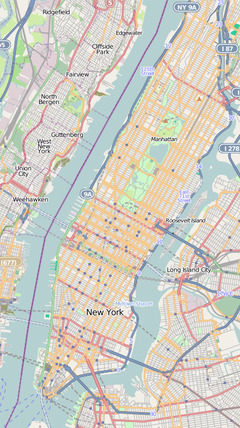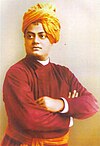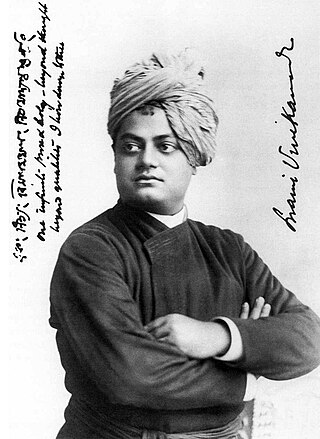
Swami Vivekananda, born Narendranath Datta was an Indian Hindu monk, philosopher, author, religious teacher, and the chief disciple of the Indian mystic Ramakrishna. He was a key figure in the introduction of Vedanta and Yoga to the Western world. He is credited with raising interfaith awareness and bringing Hinduism to the status of a major world religion in the late nineteenth century.

Ramakrishna Math and Ramakrishna Mission (RKM) is a spiritual and philanthropic organisation headquartered in Belur Math, West Bengal. The mission is named after the Indian Hindu spiritual guru and mystic Ramakrishna. The mission was founded by Ramakrishna's chief disciple Swami Vivekananda on 1 May 1897. The organisation mainly propagates the Hindu philosophy of Vedanta–Advaita Vedanta and four yogic ideals – Jnana, Bhakti, Karma, and Raja yoga. The mission bases its work on the principles of Karma Yoga, the principle of selfless work done with a dedication to God.

Sri Sarada Devi, born Kshemankari / Thakurmani / Saradamani Mukhopadhyay, was the wife and spiritual consort of Ramakrishna Paramahamsa, a nineteenth-century Hindu mystic. Sarada Devi is also reverentially addressed as the Holy Mother by the followers of the Sri Ramakrishna monastic order. The Sri Sarada Math and Ramakrishna Sarada Mission situated at Dakshineshwar is based on the ideals and life of Sarada Devi. She played an important role in the growth of the Ramakrishna Movement.
Swami Nikhilananda (1895–1973), born Dinesh Chandra Das Gupta was a direct disciple of Sri Sarada Devi. In 1933, he founded the Ramakrishna-Vivekananda Center of New York, a branch of Ramakrishna Mission, and remained its head until his death in 1973. An accomplished writer and thinker, Nikhilananda's greatest contribution was the translation of Sri Sri Ramakrishna Kathamrita from Bengali into English, published under the title The Gospel of Sri Ramakrishna (1942).

Swami Virajananda, born Kalikrishna Bose, was an initiated disciple of Sarada Devi and the sixth president of the Ramakrishna Order. Born as the son of Trailokyanath Bose and Nishadkalidevi, Virajananda was the first person to join the Ramakrishna Order after the direct disciples of Ramakrishna. In 1897, he was initiated into sannyasa by Vivekananda. From 1899 onward he served in Advaita Ashrama, Mayavati and became its president in 1906. He is recognised as a monastic disciple of Vivekananda.

Ramakrishna Math is the administrative legal organization of the Ramakrishna Order, of Daśanāmi Sampradaya. It was set up by sanyasin disciples of Ramakrishna Paramhansa headed by Swami Vivekananda at Baranagar Math in Baranagar, a place near Calcutta, in 1886. India. The headquarters of Ramakrishna Math and its twin organisation, Ramakrishna Mission is at Belur Math.

Ramakrishna Paramhansa Deva had sixteen direct disciples who became monks of the Ramakrishna Order; they are often considered his apostles. In the Ramakrishna-Vivekananda movement, the apostles have played an important role. Apart from Swami Vivekananda, the direct disciples or apostles of Ramakrishna were as follows.

Vedanta Societies refer to organizations, groups, or societies formed for the study, practice, and propagation of Vedanta, the culmination of Vedas. More specifically, they "comprise the American arm of the Indian Ramakrishna movement" and refer to branches of the Ramakrishna Order located outside India.

Sister Gargi, born Marie Louise Burke, was a writer and an eminent researcher on Swami Vivekananda, and a leading literary figure of the Ramakrishna-Vivekananda movement. Gargi was introduced to the Ramakrishna-Vivekananda movement in 1948 by Swami Ashokananda. She is known for her six-volume work, Swami Vivekananda in the West: New Discoveries. Her New Discoveries are considered as indispensable for Swami Vivekananda research.

Swami Abhedananda, born Kaliprasad Chandra, was a direct disciple of the 19th century mystic Ramakrishna Paramahansa and the founder of Ramakrishna Vedanta Math. Swami Vivekananda sent him to the West to head the Vedanta Society of New York in 1897, and spread the message of Vedanta, a theme on which he authored several books through his life, and subsequently founded the Ramakrishna Vedanta Math, in Calcutta and Darjeeling.
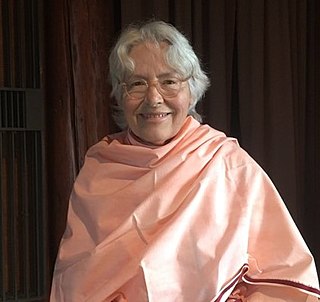
Pravrajika Vrajaprana is a sannyasini or pravrajika at the Vedanta Society of Southern California, affiliated with the Ramakrishna Order. She resides at Sarada Convent in Santa Barbara, California and a writer on Vedanta, the history and growth of the Vedanta Societies.
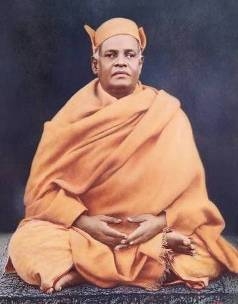
Saradananda, also known as Swami Saradananda, was born as Sarat Chandra Chakravarty in 1865, and was one of the direct monastic disciples of Ramakrishna. He was the first Secretary of the Ramakrishna Math and Ramakrishna Mission, a post which he held until his death in 1927. He established the Udbodhan house in the Bagbazar area of Calcutta, which was built primarily for the stay of Sri Sarada Devi in Calcutta, from where he used to publish the Bengali magazine Udbodhan. There he wrote Sri Sri Ramakrishna Lilaprasanga in Bengali, on the life of Ramakrishna, which was translated into English as Sri Ramakrishna, the Great Master. He is believed to be reincarnation of Saint Peter and he allegedly went into Samadhi when he was in the Saint Peter Church and said that "I remembered my past" and wrote in his diary that "Saint Peter again."
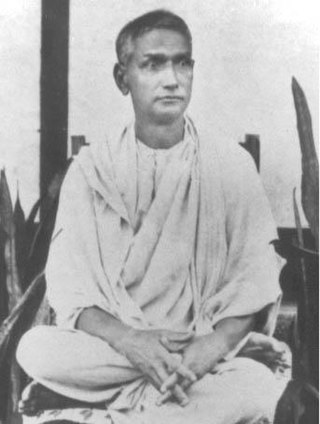
Nirmalananda, born as Tulasi Charan Dutta in Calcutta, was a direct disciple of Ramakrishna, the 19th-century mystic and Hindu saint from India, and took Sanyasa from Vivekananda along with Brahmananda and others. He was initiated by Sri Ramakrishna, on which fact a few latter-day antagonists tried to cast doubt in the Bangalore Court, but into which question the Court refused to get into. Nirmalananda played a key role in establishing Ramakrishna Math and Mission chiefly in South India, in Kerala and Bangalore and Tamil Nadu and also in the USA, Burma and Bangladesh.

Josephine MacLeod was an American friend and devotee of Swami Vivekananda. She had a strong attachment to India and was an active participant in the Ramakrishna Vivekananda movement. She was given the nicknames "Tantine" and "Jo Jo" by Vivekananda. She considered Swami Vivekananda to be her friend and helped him with his finances. MacLeod was not a sanyasin, unlike many others such as Sister Nivedita or Sister Christine. She was instrumental in spreading Vivekananda's message on Vedanta in the West. She made many contributions to the initial and the later phases of the development of the order of Ramakrishna and Vivekananda. She was a contributor to many causes espoused by Sister Nivedita, the most famous disciple of Vivekananda, including that of contributing financially towards the development of the Indian National Movement especially in Bengal and elsewhere in India.

Sister Christine or Christina Greenstidel was a school teacher, and close friend and disciple of Swami Vivekananda. On 24 February 1894, Christine attended a lecture of Vivekananda in Detroit, United States which inspired her. She started communicating with Vivekananda through letters. Christine went to India in 1902 and began working as a school teacher and a social worker.
Alambazar Math is the second monastery of the Ramakrishna Order established in February 1892, which remained the order's headquarters till February 1898, when it was finally moved to Belur village on the bank of Ganga.

Swami Sadananda, born Sharat Chandra Gupta, popularly known as Gupta Maharaj in the Ramakrishna Order, was a direct monastic disciple of Swami Vivekananda. He was the first disciple according to some sources. He took his monastic vows and joined Baranagar Math to serve the other disciples of Sri Ramakrishna in 1888–89 and subsequently joined the Belur Math when it was established. He was one of the leaders of early Ramakrishna Mission in its relief work. One of his significant contributions was providing relief to the citizens of Calcutta during the plague epidemic of 1898–99. He traveled to Japan in 1903. His later days were spent in company of Sister Nivedita as her protector and guide. His notable contribution in the later part of his life was preaching the message of Swami Vivekananda, especially among youth.

Ramakrishna Mission Sevashrama, Kankhal (RKMS) is in its present form is a 190-bed multi-specialty charitable hospital in Kankhal, Haridwar in Uttarakhand. It is a branch of Ramakrishna Mission, and was established in 1901 by Swami Kalyanananda, one of the direct monastic disciples of Swami Vivekananda. The hospital serves the treatment needs of poor patients in and around Uttarakhand. Since its inception it has treated more than 10 million patients. From a modest beginning in a rented two room dilapidated building it has grown to be a multi-specialty hospital for treatment of impoverished and needy people, under the supervision of the monks of Ramakrishna Order. The hospital is located in an 18 acres campus, and houses Gynecology and Obstetrics, Pediatrics, Intensive Care Units, Pathological laboratory, Blood bank, Operation Theaters etc. in addition to dairy and agricultural land whose products are used for the consumption of poor in patients.

Dhanraj Giri (1811–1901) was the abbot of Kailash Ashram, an ashram, which he established in 1880 at Muni Ki Reti, Rishikesh. It was one of the first large ashrams to be established in Rishikesh, prior to which it was mostly as a place for individual seekers, or pilgrims to stop over on way to Char Dham temples pilgrimage. He was a famous monk in Northern India and was a scholar in Vedanta philosophy. He was well acquainted with spiritual luminaries of nineteenth century India like Swami Vivekananda.

Swami Prakashananda (1874–1927) was a monastic disciple of Vivekananda and a monk of the Ramakrishna Order who played a major role in propagating and promoting the Vedanta philosophy and Vivekananda's message in India and America. He came to the US in 1906 to serve under Trigunatitananda, a direct disciple of Ramakrishna at the Vedanta Society of San Francisco, later renamed as Vedanta Society of Northern California, and later became its president.

